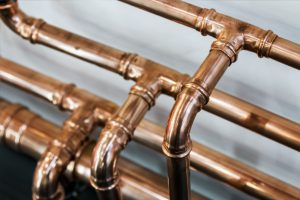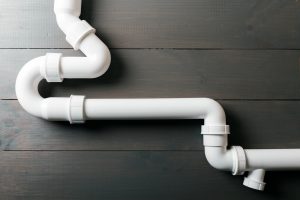Plastic Pipe Vs Copper Pipes: Which One’s Best For Your Home?
Date: March 16, 2019
PLASTIC VS COPPER WATER PIPES: THE PRO’S AND CON’S OF DIFFERENT TYPES OF PLUMBING PIPES
When it comes to your plumbing needs, there are many choices to make — but none as foundational as the choices you make regarding your pipes. Whether you’re deciding between plastic vs copper water pipes, it’s important to stick to your decision as you are not able (or securely able) to attach together two pipes of different materials. Switching material mid-way through a project means wasted time and money as you’d have to replace all parts. Therefore, before you construct, you need to decide: copper pipe vs plastic pipe (PVC). So, here’s a deep dive into the two types of plumbing pipes before you decide what works for you.
COPPER PIPES
Copper pipes are the traditional form of plumb pipings. Offering plumbers the flexibility of switching out parts, it was the highly popular choice when it came to pipe insulation. While it has had a lot of time as a market leader in plumbing insulation, is it still the best option for you?
THE BENEFITS
• Durable, they can last a long time
• Can handle the heat without losing strength
• Resists corrosion and high water-pressure
• More easily usable outdoor
• A long history of durability and long-term usage
THE CONS
• More expensive and less flexible than plastic pipes
• Tap water may taste metallic if not treated with filtering (such as reverse osmosis)
• Not resistant to sweating (insulation)
• Pipes can burst if water freezes
OVERALL,
Copper pipes have a long-standing history of working well in homes. More popularized than other metals thanks to its softer material and flexibility, copper pipes are slightly more resistant to water corrosion than other metallic pipes and generally is durable for the long-term whereas plastic pipes are not. Because copper is still metallic in nature, it is a conductor of heat meaning that heat or cooling can get lost as water travels. This also poses a danger to children. If a copper pipe is exposed outdoor (or even indoor) where children can put their hands on it, there is a potential risk of harm. Still, copper pipes have been used throughout time simply because it is good material that lasts a long time.
PLASTIC PIPES (PVC)
Plastic pipes are growing in popularity thanks to a number of factors — namely flexibility and price. While there are some generalizations that can be made across the different types of material, we’ll be focusing on Polyvinyl chloride (PVC), one of the more commonly used plastic pipes throughout.
THE BENEFITS
• Resistant to many acids and halogens
• Can carry hot water if skilled plumber chooses the correct material
• Simple install options
• Cheap/lower price point (as compared to copper pipes)
• Low noise emission
• Little to no temperature conduction (heat won’t get lost as water travels)
THE CONS
• Not resistant to solvent
• Choosing the correct PVC pipes for hot water may be tricky to ensure the longevity of pipe (you will need a professional plumber to assess the pipe)
◦ Vulnerable to expansion and shrinkage pending the temperature of the liquids
• Shorter pipe life
• Weaker material — may need support
• Not ideal for outdoor use (UV light can damage plastic pipes)
• If using underground for plumbing, may need support
ALTERNATIVE PLASTIC PIPE OPTIONS
PEX (cross-link polyethylene) is another popular type of plumbing pipe. While it is better than PVCs at insulating heat, one of its major drawback is that it is more difficult to install than traditional PVC pipes.
uPVC (unplasticized polyvinyl chloride) are the longest-running plastic pipes to date, making them a key player in the different types of plumbing pipes. The major difference between uPVC and PVC pipes is that uPVCs tend to be harder and more rigid. While they are flexible with the use of heat to mold their shapes, they are (because of that fact) also vulnerable to being shaped if exposed to extremely hot water. Of course, its threshold for heat is much higher than PVC. Its major difficulty is its inflexibility as compared to other forms of plastic pipes.
CPVC (post chlorinated polyvinyl chloride) as compared to PVC also hold the added benefit of withstanding corrosive water at higher temperatures. They also happen to be more flexible to PVC. What’s more, CPVC’s material lining makes it more resistant to bacteria growth. It does perform better, so CPVC is the better choice right? Yes, if you ignore price. While PVC can go for $0.40 /ft., CPVC goes for $2.50 /ft. Making it the much steeper priced product.
OVERALL,
There are many types of plumbing pipes, more than we were able to list. With all that said, one of the major weaknesses of plastic pipes is their ability to conduct heat. While PVC pipes can handle up to 140 degrees Fahrenheit, the material is toxic if burned. As such, it is important to watch the heat levels it will most likely interact with.
When trying to decide if plastic vs copper water pipes are for you, there are a few questions you’ll have to ask yourself. Will the pipes be exposed outdoors, face intense heat, face different types of water with inorganic material? Clearly, there are different pros and cons to copper pipes vs PVC. And even with the PVC world, there are still assortments of alternative plastic pipe options. If you have questions on which plastic pipes are for you, our Comfort Heroes are here to save the day and answer all your questions!


